|
  This
species of hosta from China has been grown in home landscapes in the United
States for a hundred years or more. It is known for its large,
pure white, fall blooming
(late August into September) flowers which
are very fragrant. A large size (25 inches high) plant, it has shiny green
foliage and the flowers are trumpet shaped. This
species of hosta from China has been grown in home landscapes in the United
States for a hundred years or more. It is known for its large,
pure white, fall blooming
(late August into September) flowers which
are very fragrant. A large size (25 inches high) plant, it has shiny green
foliage and the flowers are trumpet shaped.
Between 1784 and 1789, the French consul at Macao in
China send seeds of this species to the
Jardin des
Plantes in Paris. At that time, it was known as
Hemerocallis plantiginea.
According to
The Hostapedia by Mark Zilis (2009), this plant had many Latin names over time including
Funkia alba grandiflora, Funkia cordata, Funkia japonica,
Funkia liliflora, Funkia subcordata grandiflora, H. plantaginea cordata,
H. plantaginea 'Grandiflora', Hosta
subcordata and
Hosta subcordata grandiflora alba.
Mark Zilis (2009), also stated that this species "...forms seed pods
reluctantly and, even when it does, there are few viable seeds...The
double-flowered 'Aphrodite' is the only known garden sport...All of
its other sports originated in
tissue culture."
 Its common names included August
Lily, Corfu Lily, Fragrant Plantainlily, Large-flowered Fragrant
Plantainlily, Subcordate Plantainlily and the White Plantainlily. Its common names included August
Lily, Corfu Lily, Fragrant Plantainlily, Large-flowered Fragrant
Plantainlily, Subcordate Plantainlily and the White Plantainlily.
From the
Field Guide to Hostas by Mark Zilis (2014), "...stands out as perhaps the most horticulturally significant hosta of the last
200 years...Any hosta with fragrant flowers can be traced back to H.
plantaginea, as it is the only fragrant species. At the same time, there are
also many non-fragrant hybrids out of H. plantaginea."
The New Encyclopedia of Hostas by
Diana
Grenfell (2009) states: "Leaves turn chartreuse in the sun...Leaves take
several weeks to completely unfurl after the shoots first sprout. It passes on
its sweet fragrance to many hybrids...Does not produce many flowers in cooler
climates where it does best planted against a sunny wall. Known affectionately
in the United States as grandmother's plant...Intensely fragrant, nocturnal,
waxy, long tubed white flowers."
This plant may have been sold at one time as
Mackwoods No. 14.
Mikiko Lockwood in an article on The Hosta Library titled,
A Little About Japanese Hosta Terms defines the term maruba as round leaf or round-leafed.
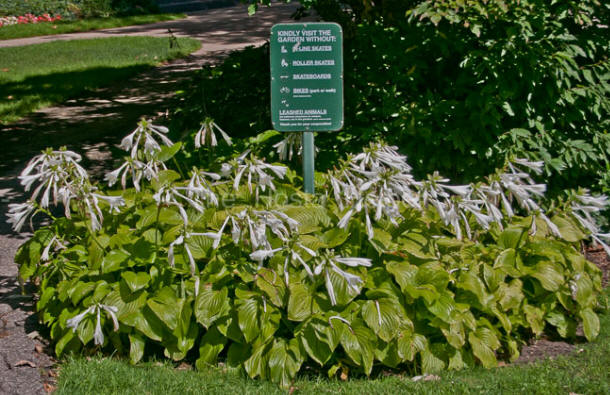


 Writing about H. 'Yae-no-oba' by Warren I. Pollock in
The
Hosta Journal (2001 Vol. 32 No. 2) states that, "This cultivar is a selection of H. plantaginea
'Aphrodite' growing in
Ralph
"Herb" Benedict's garden...according to
Ron Williams of House of Hosta in Green
Bay, Wisconsin, who introduced it, is a "vast improvement over H. plantaginea
'Aphrodite' as it blooms profusely each year"...(Pollock continues) I've also
found that these H. plantaginea plants flower better if the weather is hot: in
the upper 80s and higher along with high night temperatures...."Yae" means "to
have two of something" in Japanese, in other words "double"..." Writing about H. 'Yae-no-oba' by Warren I. Pollock in
The
Hosta Journal (2001 Vol. 32 No. 2) states that, "This cultivar is a selection of H. plantaginea
'Aphrodite' growing in
Ralph
"Herb" Benedict's garden...according to
Ron Williams of House of Hosta in Green
Bay, Wisconsin, who introduced it, is a "vast improvement over H. plantaginea
'Aphrodite' as it blooms profusely each year"...(Pollock continues) I've also
found that these H. plantaginea plants flower better if the weather is hot: in
the upper 80s and higher along with high night temperatures...."Yae" means "to
have two of something" in Japanese, in other words "double"..."
An article about flower fragrance by
Dr. Ben J.M. Zonneveld of the
Netherlands in
The
Hosta Journal (2002 Vol. 33 No. 2) states that, "As far
as I know, H. plantaginea is the only fragrant hosta species. All of the more
than 50 other fragrant hosta cultivars are hybrids of plantaginea...Where
I live, near the coast of
The Netherlands, the average summer temperature is
only about 18░C (65░F). This means that plantaginea has so far only
flowered once for me in five years."
 Bill Meyer in
The
Hosta Journal (2003 Vol. 34 No. 1) states that, "H. plantaginia...has contributed all the fragrance found in modern hybrids...It is
unique in continuing to produce new leaves until it blooms, it tends to add
vigor and size to its hybrids, it gives increased flower size and almost always
fragrance and it performs well in warmer climates. There are a few serious
negative traits...the worst is that it is very difficult to combine with other
species...adds markedly decreased frost-resistance...trouble blooming in
cool-summer climates, very poor fertility in later generations and a strong
resistance to blue waxes and
lutescent yellow coloring." Bill Meyer in
The
Hosta Journal (2003 Vol. 34 No. 1) states that, "H. plantaginia...has contributed all the fragrance found in modern hybrids...It is
unique in continuing to produce new leaves until it blooms, it tends to add
vigor and size to its hybrids, it gives increased flower size and almost always
fragrance and it performs well in warmer climates. There are a few serious
negative traits...the worst is that it is very difficult to combine with other
species...adds markedly decreased frost-resistance...trouble blooming in
cool-summer climates, very poor fertility in later generations and a strong
resistance to blue waxes and
lutescent yellow coloring."
W. George Schmid in
The
Hosta Journal (2006 Vol. 37 No. 1) says, "Fragrance is
obviously simple to attain. H. plantaginea must be in the mix to create fragrant
hybrids. Some Japanese booklets claim that other hostas are also purveyors of
fragrance in hybridizing, but I will believe it when I smell it."
An article about favorite flowering hostas by Steve Chamberlain in
The
Hostta Journal (2006 Vol. 37 No. 2) says, "My four
favorites are: (1) H. plantaginea - when it blossoms, there is just nothing like it.
Size, purity of white, fragrance! (2) H. ventricosa - the ark purple gets me every
time. (3) H. 'Academy Flora' - the pale lavender flowers are arrayed 360░ around the
short scapes. You can grow this one for the flowers in a non-hosta garden. (4) H.
'Matthew J. Walton' - an H. ventricosa hybrid...with very large leaves and very
large bell-shaped blooms. The color isn't quite as dark as the species, but the
scapes are fairly tall and the flowers spectacular."
 In
The
Hosta Journal (2006 Vol. 37 No. 2) W. George Schmid
comments on his favorite flowering hostas, "The best
flowers are on H. plantaginea and its multi-petalous cousins, 'Venus'
and
'Aphrodite'...H. capitata in bud is fine, but its offspring, 'Nakaimo' has
flowers that begin with the shine of precious porcelain and stay closed in bud
longer...H. kikutii forms all have fine and late flowers, but the best are on
H. kikutii var. densa (H. densa). They are white and form a tight bunch at the top
of the scape. H. laevigata has large, spidery flowers in abundance; its cousin
H. yingeri has smaller ones with the same spidery character and dark color.
These spidery flowers are carried all around the stem unlike other hosta flowers
that, "lean to one side...Finally, mature clumps of 'Blue Angel' and 'Elegans'
have a beautiful flower display when many flowers on different scapes open in
unison..." In
The
Hosta Journal (2006 Vol. 37 No. 2) W. George Schmid
comments on his favorite flowering hostas, "The best
flowers are on H. plantaginea and its multi-petalous cousins, 'Venus'
and
'Aphrodite'...H. capitata in bud is fine, but its offspring, 'Nakaimo' has
flowers that begin with the shine of precious porcelain and stay closed in bud
longer...H. kikutii forms all have fine and late flowers, but the best are on
H. kikutii var. densa (H. densa). They are white and form a tight bunch at the top
of the scape. H. laevigata has large, spidery flowers in abundance; its cousin
H. yingeri has smaller ones with the same spidery character and dark color.
These spidery flowers are carried all around the stem unlike other hosta flowers
that, "lean to one side...Finally, mature clumps of 'Blue Angel' and 'Elegans'
have a beautiful flower display when many flowers on different scapes open in
unison..."
In an article in
The
Hosta Journal (2016 Vol. 47 No 2), the author
described this plant's flowers as having a "Very Strong"
fragrance compared to other hostas.


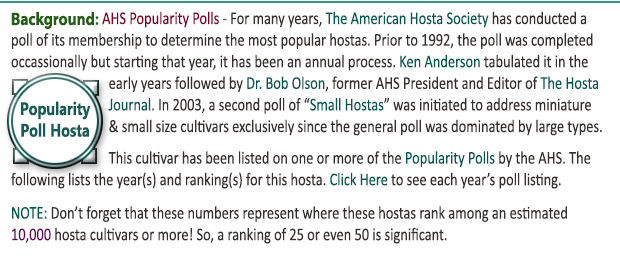 |
 |
 |
 |
| 7 |
19.1 |
1975 #4
1985 #8
1990 #29 |
1991 #23
1992 #23
1997 #23 |
1999 #24 |
|
|
|
|
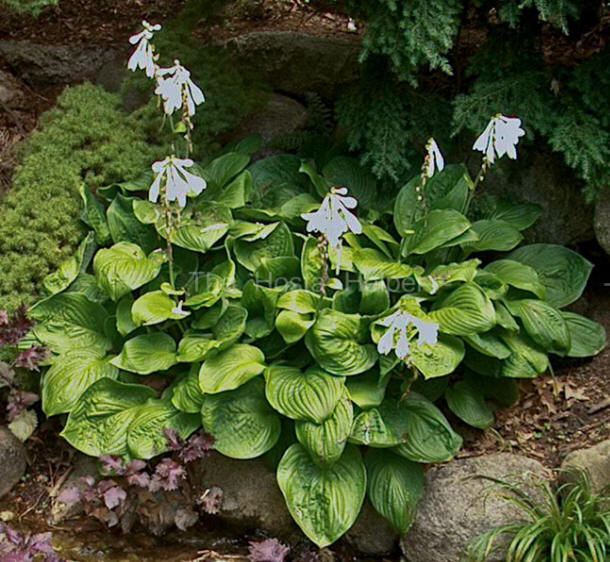


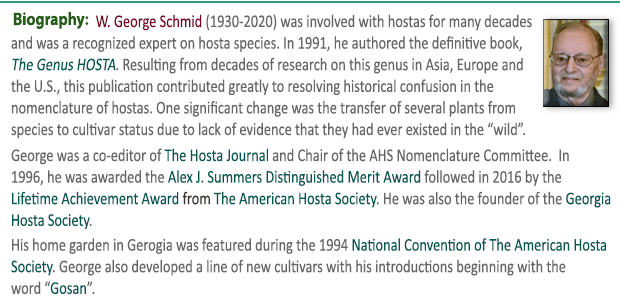
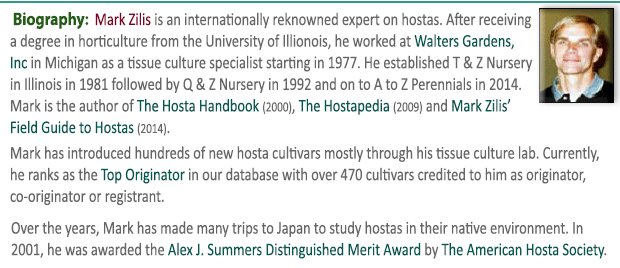




 |



